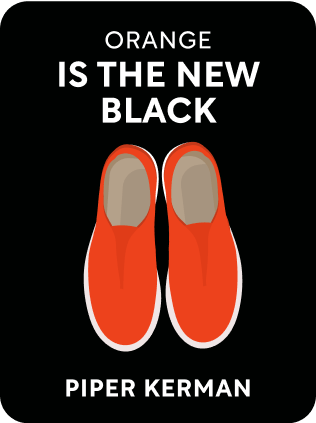

This article is an excerpt from the Shortform summary of "Orange Is The New Black" by Piper Kerman. Shortform has the world's best summaries of books you should be reading.
Like this article? Sign up for a free trial here .
What are the most important Orange Is the New Black themes? What do they mean?
These six Orange Is the New Black themes help explain major issues in the book and why they matter. Piper’s experience and observations help form these themes.
Check out the following Orange Is the New Black themes.
Orange Is the New Black Themes
These Orange Is the New Black themes talk about major ideas Piper considers during her time in prison. Read about these themes and consider Piper’s experiences.
Race
One of the things that first struck Piper was how much race determined and defined the culture at Danbury. Segregation was the unwritten rule behind bars—although there were some exceptions, most people hung out in racially homogenous groups, with little intermingling across racial lines. In these early days of her prison sentence, most of Piper’s friends were white, predominantly Italian-American. The prison officials reinforced this by lumping racial groups together into the same cell blocks, which, characteristically, bore stereotyped names (“Spanish Harlem” for the Latina inmates, “The Ghetto” for the African-American inmates).
She saw the racial solidarity during her first days at camp, when a series of white inmates gifted Piper various provisions from the commissary, because they knew that she didn’t yet have the money to purchase anything. This, Piper learned, was a ritual performed by all the racial groups at Danbury with new arrivals.
In conversations with other women, Piper saw that they freely discussed one another’s lengths of imprisonment. She was baffled by the seeming randomness of different inmate sentences, as women convicted of similar offenses often received wildly divergent punishments. It was also clear that there was racial bias built into the criminal justice system, as women of color tended to have disproportionately harsher sentences than white inmates who’d committed similar offenses.
Religion
Another one of the Orange is the New Black themes is the idea of religion. In her heightened and deteriorated emotional state, Piper lashed out. One day running on the track, she smacked a particularly annoying and loud “Jesus Freak” named LaRue who happened to be on the track with her at the same time. LaRue was known for making loud and ostentatious declarations of her faith. She recognized that her dislike of LaRue was irrational and mean, and was more about her inability to cope with her feelings than it was about LaRue. Piper was ashamed that prison had transformed her into someone capable of inflicting violence on someone else.
Through it all, Pop urged her not to let the injustices of prison turn her bitter and jaded. In conversations with another inmate named Gisela, Piper also began to understand the fulfilling role that faith played in the lives of many women at Danbury. Piper, although nominally Episcopalian, had always been quite secular, with religion never playing an important role in her life. Now, she saw that she had been wrong to look askance at faith. Gisela’s relationship with God was joyful and affirming. Rather than treating God like a vehicle for wish fulfillment, Gisela’s approach to spirituality was focused on what others needed from her. In a place like a federal prison, this could be a tremendous force for good.
Prison Beauracracy
As November turned to December, Piper began to eagerly anticipate her March release. She was in the final stretch of her sentence, tantalizingly close to closing this chapter in her life. Piper was not the only one whose thoughts were drifting to life after Danbury. Pop and Natalie were also slated for release, when they would be living together at a halfway house on Brooklyn’s Myrtle Avenue (known as “Murder Avenue” by Danbury’s Brooklynites). When she got out, Piper would likely be headed to the same halfway house.
Her impending release made it clear to Piper just how woefully inadequate the prison system’s pre-release programming was. It was meant to help inmates adjust to life on the outside, but these pre-release programs offered no information about how to access health and reproductive care services (obviously a priority for destitute women), find a job, secure housing, get drug treatment, and regain custody of their children. These were urgent needs for all of these women and they were entirely unaddressed by the pre-release program. This is one of the most frustrating Orange is the New Black themes.
Sexuality
Sex was on the minds of almost everyone at Danbury. The prisoners were deprived of the company of their partners, creating an atmosphere of sometimes aching sexual repression and lust. Piper was no stranger to this feeling, never having experienced the sensation of being deprived of Larry for so long.
Piper grew increasingly lustful for Larry. The “no touching” visiting hours rule became increasingly difficult to obey, though Piper feared the consequences of defying it. One particularly harsh CO (nicknamed “Gay Pornstar” for his mustache, which reminded the inmates of male stars of adult films from the 70s and 80s) was known to strictly enforce this rule, threatening to cancel visits altogether if he saw even the slightest contact between a visitor and an inmate. Piper began to wonder if her relationship could withstand the stress of her incarceration.
The women of Danbury found unique ways to cope with pent-up sexual frustration. One prisoner, a proud hillbilly nicknamed “Pennsatucky,” even discussed with Piper the subtle art of making homemade prison dildos using sporks, maxi pads, and rubber gloves.
Piper knew that many heterosexual women engaged in brief, experimental same-sex relationships during the period of their incarceration—going “gay for the stay” as it was called—but she was determined to remain faithful to Larry, regardless of her own romantic history with women. Eventually, Piper politely, but firmly rebuffed Crazy Eyes’s advances, telling her that she hoped she would eventually find the “real woman” she was looking for. To Piper’s great relief, Crazy Eyes backed off.
Confinement
Piper knew that furlough—a temporary, conditional release from prison—was technically possible under certain circumstances. Perhaps this family emergency would qualify. The other inmates, however, told her that furlough was a pipe dream and lost cause. The veteran prisoners told Piper that they had never seen an approved furlough request in all their years at Danbury. Piper requested it anyway. She knew it was a longshot, but what other choice did she have?
The cynics proved right in the end. Piper’s furlough request was quickly and unceremoniously denied by the Bureau of Prisons. Piper entered a state of deep anger and depression, unable to enjoy the company of her friends, visits from family, the rhythms and rituals of daily prison life, or even special occasions like the Halloween party. She felt miserable and utterly powerless. She did manage to have a brief phone conversation with her grandmother from Finn’s office, after which she broke down sobbing.
Friendship
Finally, friendship is one of the most important Orange is the New Black themes. Piper’s friends are mainly what got her through her time in prison. Maintaining some semblance of normalcy and connection to the outside world was crucial to survival and sanity at Danbury. Piper, Rosemarie, and another inmate named Carlotta would plan their future weddings, thinking about the guest list, the food, the venue, and the music selection. All of this was a lifeline to the world outside of prison and a way of clinging to a better and more hopeful future. Piper and Rosemarie wanted to get married because they loved their partners. Carlotta, on the other hand, wanted to wed so she could lord her happy, stable life over the dysfunctional women she had grown up with, or, as she put it, “so bitches can hate.”

———End of Preview———
Like what you just read? Read the rest of the world's best summary of Piper Kerman's "Orange Is The New Black" at Shortform .
Here's what you'll find in our full Orange Is The New Black summary :
- The real, more nuanced story behind the hit TV show
- How upper-class Piper Kerman landed in prison on drug charges
- The key lessons Kerman learned about society and herself






